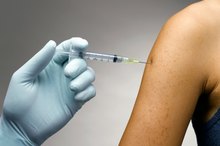How Effective Is Pull Out Method for Birth Control?
For many years, the joke went, that there's a name for people who use the pull-out method of birth control, also called coitus interruptus or withdrawal. That name is "parents." The implication is that the method is not a viable or effective means of preventing pregnancy. Many people believed that the pre-ejaculatory fluid, emitted from the penis prior to true ejaculation at orgasm, contained sperm and could cause pregnancy. Several scientific studies show that both assumptions are incorrect—that "precum" normally contains no sperm, and that when practiced correctly, withdrawal can be a method of birth control with reliability on par with condoms.
New Respect
Research performed at the Guttmacher Institute has shown that no active sperm are expelled in the pre-ejaculatory fluid. So when the withdrawal method is correctly and consistently used, it successfully prevents pregnancy 96 percent of the time. This compares to the 98 percent success rate achieved by condom usage, in what is called "perfect use."
'Nobody's Perfect'
What are the Chances of a Vasectomy Failing?
Learn More
Study author Rachel K. Jones notes that, "nobody's perfect," a caveat that points out that the withdrawal method of birth control is easy to practice incorrectly. Men must pull out 100 percent of the time prior to the first "squirt" of ejaculation. When partners fail to pull out on time, every time, the failure rate grows to 27 percent. The failure rate average of those who practiced the technique correctly, combined with those did it incorrectly, what is called "typical use," was 18 percent, only slightly higher than the 17 percent failure rate of typical use for condom users.
- Study author Rachel K. Jones notes that, "nobody's perfect," a caveat that points out that the withdrawal method of birth control is easy to practice incorrectly.
- The failure rate average of those who practiced the technique correctly, combined with those did it incorrectly, what is called "typical use," was 18 percent, only slightly higher than the 17 percent failure rate of typical use for condom users.
Increasing Effectiveness
A common source of failure when using the withdrawal method happens when men fail to urinate between rounds of sex, according to Planned Parenthood 2. Sperm can remain in the urethra after an ejaculation, and that sperm could fertilize his partner if pushed out by the pre-ejaculatory fluid during a subsequent episode of sex. Urination is believed to wash out the urethra of any sperm. Men practicing the withdrawal method should always urinate after ejaculating when planning to re-enter his partner. Care should also be taken so that no sperm ends up on the vulva. Men should also wash their hands after sex so that no sperm is delivered to the vagina during subsequent foreplay.
- A common source of failure when using the withdrawal method happens when men fail to urinate between rounds of sex, according to Planned Parenthood 2.
- Men should also wash their hands after sex so that no sperm is delivered to the vagina during subsequent foreplay.
No STD Protection
The Process of Human Reproduction
Learn More
The withdrawal method does not prevent sexually transmitted diseases. Only the various forms of male and female condoms can prevent STDs since they are the only methods that provide a physical barrier to prevent the sharing of bodily fluids. Therefore, to prevent the spread of STDs, only committed, monogamous couples should consider using the pull-out method.
Fertility Awareness
The pull-out method works best for monogamous couples whom cannot tolerate hormones or other forms of birth control, and may work best in combination with fertility awareness methods, otherwise known as the rhythm method, where the female reproductive cycle is charted, and extra care is taken around the time of ovulation, when pregnancy is most likely to occur.
Related Articles
References
- ABC News
- Planned Parenthood
- Killick SR, Leary C, Trussell J, Guthrie KA. Sperm content of pre-ejaculatory fluid. Hum Fertil (Camb). 2011;14(1):48–52. doi:10.3109/14647273.2010.520798
- Jones RK, Lindberg LD, Higgins JA. Pull and pray or extra protection? Contraceptive strategies involving withdrawal among US adult women. Contraception. 2014;90(4):416–421. doi:10.1016/j.contraception.2014.04.016
- Centers for Disease Control and Prevention. Effectiveness of family planning methods. Updated 2011.
- Centers for Disease Control and Prevention. Condoms and STDs: fact sheet for public health personnel.
- Planned Parenthood. Withdrawal (Pull Out Method).
Writer Bio
Luke J. Terry practices acupuncture, natural medicine, and holistic nutrition in Greenwood Village, Colo. He writes articles and offers consulting on a wide array of topics such as nutrition, health, vitality, biomechanics, disease prevention, consciousness and spirituality. He graduated with honors, earning a master’s degree from Emperor’s College of Traditional Oriental Medicine.








